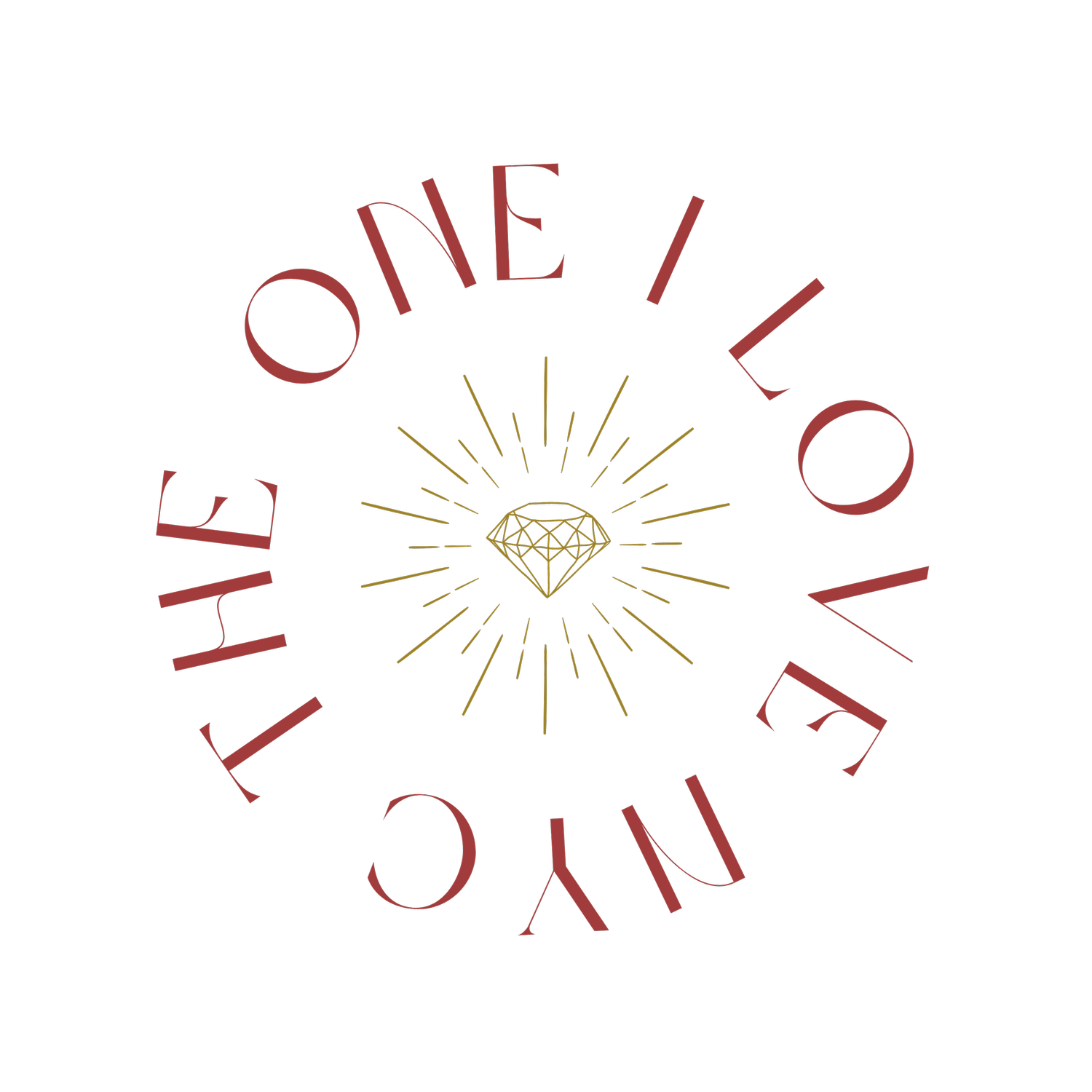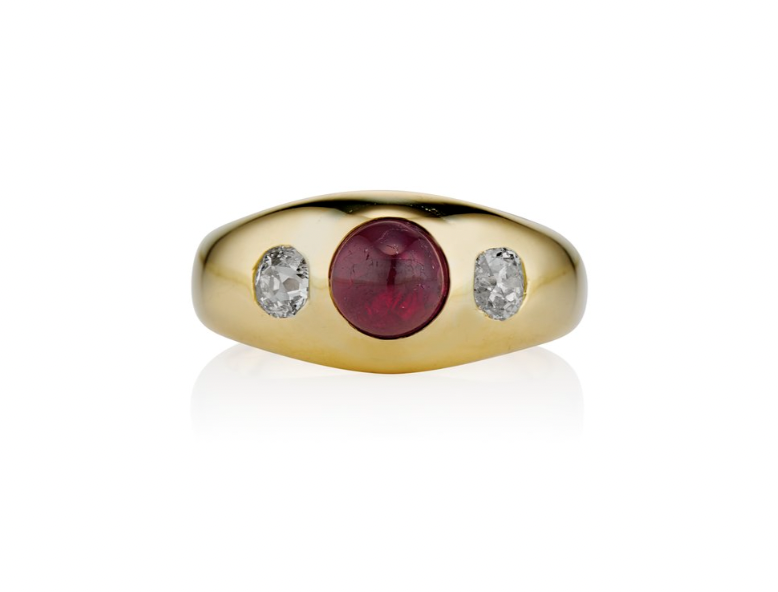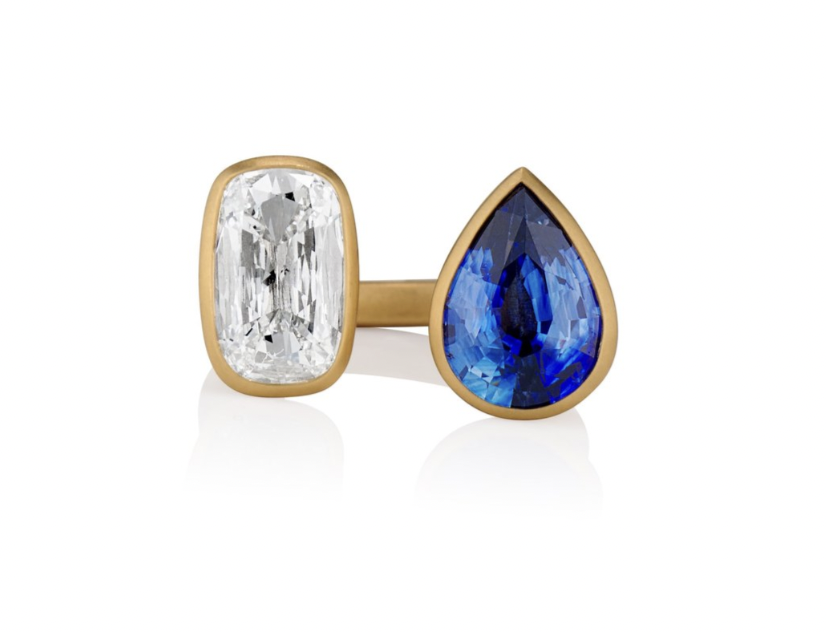Corundum Conundrum: Rubies vs Sapphires
Corundum is one of the world’s most prized minerals but you likely know it by its more common name: ruby and sapphire. It turns out that rubies and sapphires have the same base mineral composition, corundum, which is aluminum oxide. Though corundum is colorless when pure, traces of other minerals lend extraordinary color that we see in the intense brilliance of rubies and the dashingly handsome blues of sapphires.
But when stacked up head-to-head, which stone takes the cake? Who is the king of the corundum? Which is the undisputed gem de la creme?
Rubies vs. Sapphires: Color
The Red Ruby Ring from the One I Love NYC’s Vintage and Contemporary Collection. Approx. 4.5ct ruby with pave sapphires and diamonds.
Rubies boast a ravishing red color. Red has many associations, evoking emotions such as strength, lust, love, and power. A 2012 study showed that waitresses wearing red made over 25% more in tips from male customers and soccer teams donning the color have better track records than teams wearing any other color. Archeologists have found that the earliest instances of dyed cloth are, indeed, red.
There are many shades of ruby, from lighter jammy reds to deep brooding reds. The value of a ruby is often based on its color, with the most valuable striking a medium tone—not too pale and not too dark. Burmese rubies are known for hitting this delicate balance just so. In Burma, now called Myanmar, locals termed the most vivid, beautifully colored rubies “ko-twe” meaning pigeon's blood, which is still today the most sought-after shade of ruby.
It wasn't until the twelfth century that the world began to embrace blue. In France, the color began to pop up in church stained glass, and the Virgin Mary’s robes shifted from the black of mourning to blue, a color that had been reborn to represent purity and holiness. Ever since, the color has skyrocketed into our hearts; researchers find that blue is the world’s favorite color.
Sapphires come in a striking array of wondrous colors. Credit: Robert Weldon/GIA, Dr. Eduard J. Gübelin Collection.
Blue sapphires are a remarkable sight to behold. From light and airy, sky blues, to the most saturated, velvety shades. But where sapphires really take it up a notch is when it comes to fancy color sapphires, which run the gamut of color. In fact, just about the only color you won’t find in the sapphire diaries is red because those would be called rubies. Pink, yellow, and orange sapphires are especially valuable. Golden mandarin orangey stones, bright and joyful canary yellow specimens, even a verdant green breath of springtime sapphire. They are a veritable rainbow of delightful glamor.
This one is close but as lovers of variety we have to call it for sapphire.
Rubies vs. Sapphires: Origins
The Ruby & Diamond Gypsy Band from The One I Love NYC’s Edwardian Collection. A fantastic Ruby Cabochon, possibly Burmese in origin, nestled between two Mine Cut Diamonds (Approx. .55ctw / H SI1.
Legend has it that rubies come from fire. Some even believed that casting a ruby into water would make it boil, and Greeks thought that these stones could melt wax. One Bengalese tale features a dashing young man who traversed foreign seas seeking a home. During his journey, glowing red balls swirling under the sea enchanted him. He fished them out of the water and brandished these glowing orbs in the next city he found. This earned the attention of a vain princess who offered him 1,000 rupees for his treasure. Not knowing their true value, he agreed. But the princess’s lust for jewels couldn’t be sated with a few rubies. The young man was forced back to the whirlpool where he originally found the stones. There he saw the god Shiva meditating in a palace with a headless woman floating above him. Her seeping blood, it turned out, created the wondrous rubies floating to the surface. Quickly, he gathered the rubies and woke the woman. They fell in love and escaped together, along with thousands of rubies.
The Folie à Deux from The One I Love NYC boasts 2.53ct Natural Sapphire alongside a 1.70ct Cushion Cut, H VS2 GIA in remarkable, buttery 22K gold.
Sapphires have a more tortured origin story. Prometheus, a Greek titan who molded humans from clay, watched his creations struggle each day on earth. Hoping to help out, he implored the gods to gift mortals with the magic of fire. When his proposal was rejected, he stole fire from Mount Olympus. A furious Zeus chained Prometheus to a rock for visits from an angry eagle that came by each day to eat his liver. A few decades later, demi-god and hero Hercules slayed the eagle and broke Prometheus's chains. But one link from the chain remained on his finger as did a chunk of his rock. This eternal ring was beautiful, blue, and immensely strong: the very first sapphire.
We’re suckers for a good love story so this one goes to ruby.
Rubies vs. Sapphires: Modern Lore
With its rich red color and well-defined star, the 138.72ct Rosser Reeves Star Ruby might be the largest and finest star ruby in the world. Gift of Mr. and Mrs. Rosser Reeves to the Smithsonian Museum in 1965. Credit: The Smithsonian Museum.
Rosser Reeves was an original Mad Man, famous for helping found the Ted Bates advertising agency in 1940. Known as “The King of the Hard Sell”, Reeves was an adamant gem collector. He caught wind of a 138-carat Sri Lankan star ruby that he purchased at auction in 1953. Though its earlier origins were shrouded in mystery, the stone was deemed “the largest and finest in the world” by the Smithsonian’s gem curator, George Switzer.
Reeves may have been the King of the Hard Sell but some believe Switzer sold even harder. Over the course of a few months, many letters, and one critical meeting, Switzer convinced Reeves to donate the gem to the Smithsonian museum. According to Switzer, Reeves became compelled to secure the stone’s place in history and cement its name as the “Rosser Reeves Ruby” for generations of curious eyes to behold. Ever the adman, Reeves spun a tale or two around the already famous ruby, saying that he was woken up during a trip to the Middle East to learn of a “great ruby” that he just had to have. He immediately flew to Istanbul just in the nick of time to swipe the stone at auction. Ever sharp and witty, Rosser Reeves once levied this quip when asked his net worth: “You don’t give away a million-dollar ruby if you’re impoverished.”
The Star of India is 563 carats, making it the world's largest gem-quality blue star sapphire. Some 2 billion years old, it is also one of the most well-known objects in the world. Credit: American Museum of Natural History.
Of course, there is an equally amazing sapphire story to match. When J.P. Morgan asked George Frederick Kunz to find the world’s most spectacular gems for the Paris Exposition of 1900 he didn’t disappoint. He sourced the Star of India, a 563-carat star sapphire, which drew much attention at the Exposition. Later the world-famous stone was donated to the American Museum of Natural History, on display for admirers from near and far. But one chilly fall night in 1964, a group of gem thieves—led by Jack ‘Murph the Surf’ Murphy—stole the Star of India. They’d unlocked a window in the bathroom during the museum’s opening hours. With this easy access point, the daring lot made a beeline to the coveted Star of India. Thanks to a dead battery in the priceless gem’s alarm system, they made out with millions. But they didn’t get too far. Tracked down within days, the stone was found in a bus station locker in Miami and returned to the museum.
This one, clearly, is a tie.
Rubies vs Sapphires: Stones of healing
Both rubies and sapphires are deeply enchanting and meaningful. And they both impact the gift of healing, inner wisdom, and divine sight. Kunz once noted that rubies could remedy hemorrhages and abate inflammation, and found records showing that this wonderful stone acted as a salve for anger and discord throughout history.
Sapphires have been known as sacred healers, powerful enough to counteract poisons and cure eye disease. Kings often wore sapphires around their necks to protect them from harm as far back as the 2nd century AD.
Both stones are absolute winners in our book. We’d always choose one of each.






